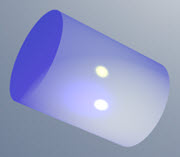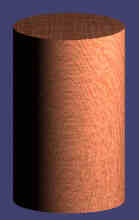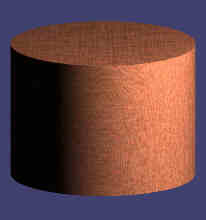Cylinder Facts
Notice these interesting things:
- It has a flat base and a
flat top - The base is the same as the top
- From base to top the shape stays the same
- It has one curved side
- It is not a polyhedron as it has a curved surface
An object shaped like a cylinder is said to be cylindrical.

Surface Area of a Cylinder
Surface Area = 2 × π × r × (r+h)
Which is made up of:- Surface Area of One End = π × r2
- Surface Area of Side = 2 × π × r × h
Example: h = 7 and r = 2
| Surface Area | = 2 × π × r × (r+h) | |
| = 2 × π × 2 × (2+7) | ||
| = 2 × π × 2 × 9 | ||
| = 36 π | ||
| ≈ 113.097 |
Volume of a Cylinder
Volume = π × r2 × h
Just multiply the area of the base by the height of the cylinder:- Area of the base: π × r2
- Height: h
- Volume = Area × Height = π × r2 × h
Example: h = 7 and r = 2
| Volume | = π × r2 × h | |
| = π × 22 × 7 | ||
| = 28 π | ||
| ≈ 87.96 |
How to remember: Volume = pizza

The radius is "z", and the thickness "a" is the same everywhere ... what is the volume?
Volume equals pi × z × z × a
(we would normally write "pi" as π, and z × z as z2, but you get the idea!)
Volume of a Cone vs Cylinder

| The volume of a cylinder is: | π × r2 × h |
| The volume of a cone is: | 1 3 π × r2 × h |
In future, order your ice creams in cylinders, not cones, you get 3 times as much!
It Doesn't Have to Be Circular

And we can have stranger cylinders!
So long as the cross-section is curved and is the same from one end to the other, then it is a cylinder. But the area and volume calculations will be different than for the above.
More Cylinders



No comments:
Post a Comment